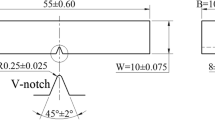Abstract
In this investigation, five estimation methods have been adopted to estimate the dynamic fracture toughness of a nuclear pressure vessel steel A508 CL3 by using pre-cracked Charpy-size specimens on an instrumented impact test machine. Furthermore, the merits and the demerits of the five methods have also been compared. The experimental results indicate that the maximum load energy method based on the curve of load versus load-point displacement overestimates the dynamic fracture toughness J Id , especially above room temperature. The method of compliance changing rate underestimates the dynamic fracture toughness. The method of measuring the critical stretch zone width (SZW c ) at the crack tip by means of SEM fractography and then converting the SZW c into J Id has a relatively large error. In addition, it is expensive and difficult to measure the SZW c . The method of energy revised at the maximum load may be considered a better single-specimen method for determining the dynamic fracture toughness. Furthermore, the results indicate that although the dynamic resistance curve method can exactly estimate the dynamic fracture toughness of the material, this method needs several specimens. Moreover, the test procedure is complicated. Thus, it is not suitable for nuclear reactor pressure vessel embrittlement surveillance.
Similar content being viewed by others
References
Serpan Jr., Z. Charles and P.N. Randall, Irradiation effects in reactor pressure vessel steels: A nuclear regulatory commission perspective. Radiation Embrittlement of Nuclear Reactor Pressure Vessel Steels, L.E. Steele (ed.) ASTM STP909, (1986) 5–22.
H. Tsukada, T. Iwadate, Y. Tanaka and S. Ono, Static and dynamic fracture toughness behaviour of heavy section steels for nuclear pressure vessels. Proceedings of the Fourth International Conference on Pressure Vessel Technology, G55/80, London, 1980, 369–374.
L.M. Davies and T. Inghab, Overview of studies in the United Kingdom on neutron irradiation embrittlement of nuclear pressure vessel steels, L.E. Steele (ed.) ASTM STP909, (1986) 23–33.
Y. Sakai, K. Miya, I. Takahashi and Y. Ando, Properties of heavy section steel plates and forgings for nuclear vessels produced in Japan (Part 2: Fracture toughness), International Journal of Pressure Vessel and Piping 22 (1986) 79–109.
ASTM E636-83, Standard Practice for Conducting Supplemental Surveillance Tests for Nuclear Power Reactor Vessel, E706 (1H), 1983.
T. Kobayashi, I. Yamamoto, and M. Niinomi, Evaluation of dynamic fracture toughness parameters by instrumented Charpy impact test. Engineering Fracture Mechanics 24 (9) (1986) 773–782.
H. Tsukada, T. Iwadate, Y. Tanaka and S. Ono, Static and dynamic fracture toughness behaviour of heavy section steels for nuclear pressure vessels, Fourth International Conference on Pressure Vessel Technology, London, May 1980, C55/80, 369–374.
H. Nakamura, H. Kobayashi and H. Nakayama, Relation between crack tip plastic blunting and J-Integral, Journal of the Society of Metal Science, Vol. 29, No. 321, (1980) 533–537 (in Japanese).
J.C. Lautridou and A. Pineau, Crack initiation and stable crack growth resistance in A508 steels in relation to inclusion distribution, Engineering Fracture Mechanics, Vol. 15, No. 1–2, (1981) 55–71.
W.L. Server, General yielding of Charpy V-notch and precracked Charpy specimens, Journal of Engineering Materials and Technology, Transactions of the ASME, Vol. 100, April 1978, 183–188.
S.R. Pati, Fracture toughness determination from side-grooved precracked Charpy specimens. Mechanism of Fracture International Conference on Fatigue, Corrosion cracking, Fracture Mechanics and Failure Analysis, Salt Lake City, USA, 1985, 487–493.
X.P. Zhang and Y.W. Shi, How to obtain a complete dependence curve of impact toughness or fracture toughness vs temperature on nuclear pressure vessel steels by using only one Charpy-size specimen, Int. Journal of Pressure Vessel and Piping, Vol. 65, No. 2, (1996) 187–192.
ASTM E813-81, Standard Test Methods for J ic , a Measure of Fracture Toughness, ASTM, Philadelphia, 1981.
X.P. Zhang and Y.W. Shi, J r resistance curves of nuclear power station pressure vessel steel A508 CL3 and its welds welded with narrow gap submerged-arc welding (in Chinese), Nuclear Power Engineering 15 (1) (1994) 74–78.
Author information
Authors and Affiliations
Rights and permissions
About this article
Cite this article
Xinping, Z., Yaowu, S. Comparative studies of several methods to determine the dynamic fracture toughness of a nuclear pressure vessel steel A508 CL3 with Charpy-size specimen. Int J Fract 81, 195–204 (1996). https://doi.org/10.1007/BF00039570
Received:
Accepted:
Issue Date:
DOI: https://doi.org/10.1007/BF00039570




